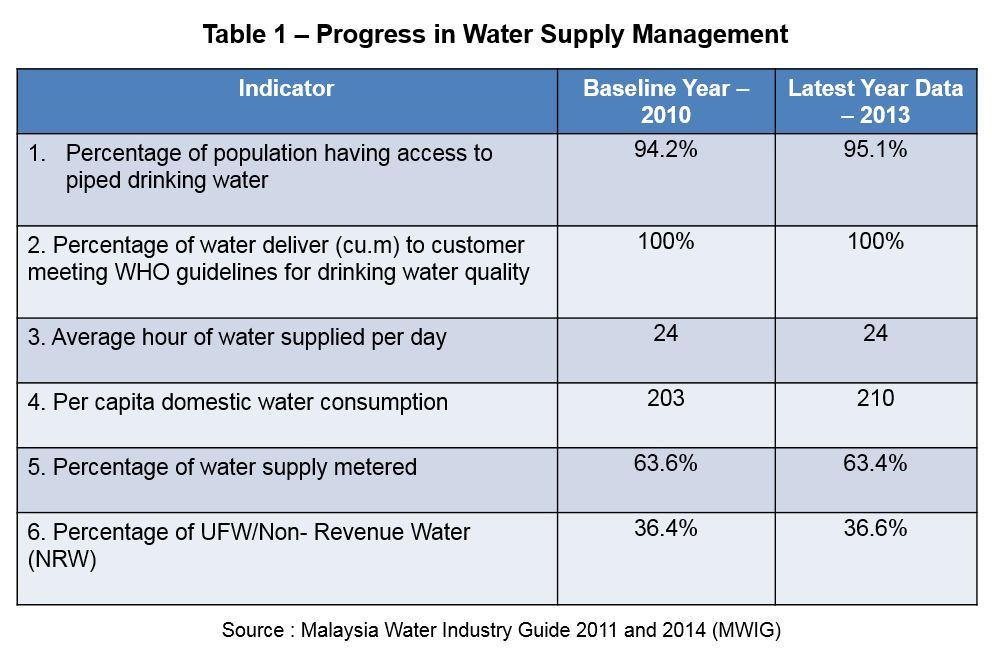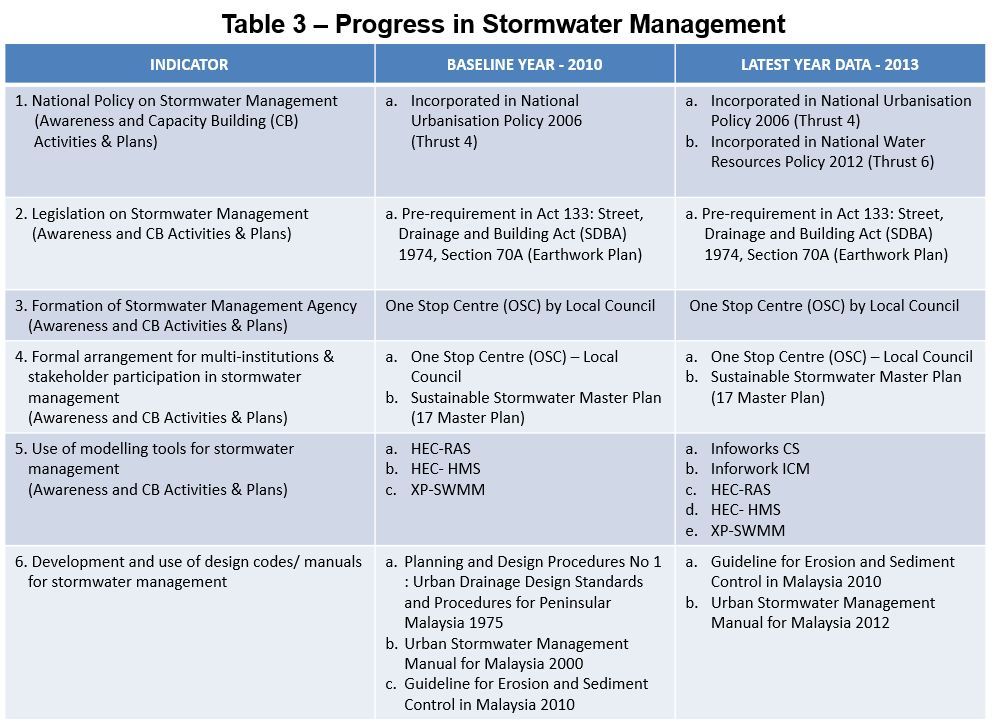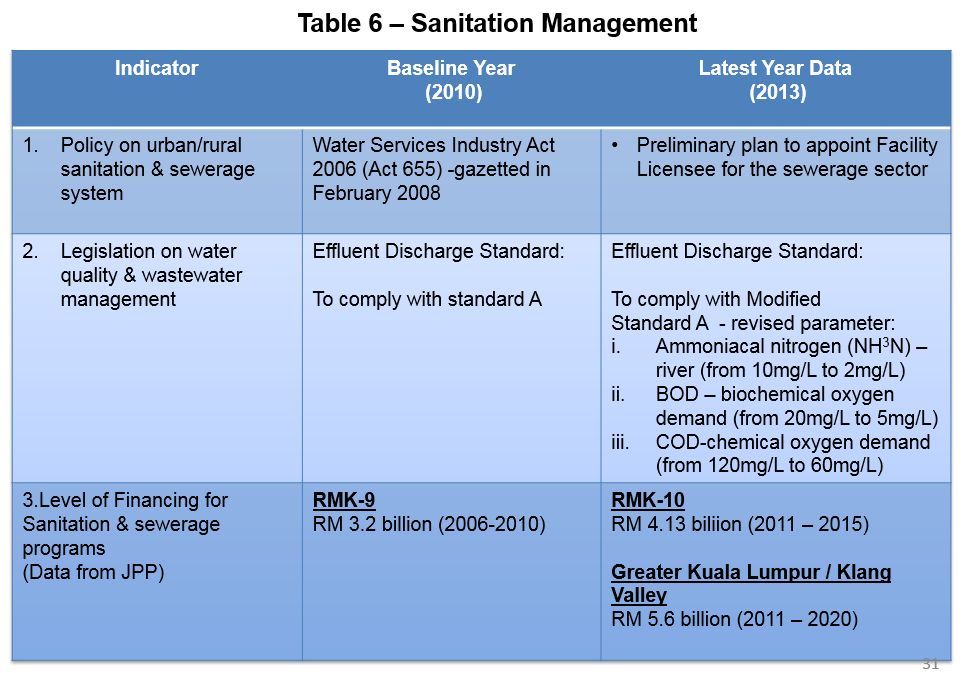Overview of IWRM in Malaysia
Figure 1 shows the hydrological balance of Malaysia. It can be seen that Malaysia has an average annual rainfall of 2940mm and the surface runoff is 1500mm with groundwater recharge of 192mm. In order to manage its water resources in an integrated way Malaysia has delineated 189 river basins that are more than 80 sq.km in size. Also, Malaysia has a total coastline of 4809km and the coastline has been classified into management units for monitoring and management purposes.

The following is an overview of the IWRM status in Malaysia for the six key water management issues.
- Water Supply Management
The following are the key challenges in water supply management in Malaysia.
- Constraints in the smooth implementation of water supply development works due to the fact that water resources management is the responsibility of the State whereas water supply development is the responsibility of the Federal government.
- Poorly-determined water tariff rates for consumers, where the tariff is not at full-cost recovery, makes it difficult for the water operators to generate sufficient cash flow to fund its capital expenditure (CAPEX), and even its operating and maintenance (OPEX) costs. Also, the low water tariff does not help in water conservation.
- There are 5 remaining states (Kedah, Pahang, Terengganu, Kelantan and Selangor) and Federal Territory of Labuan that are still in the process of restructuring their water supply system to the WSIA asset–light model.
- Low level of consumer awareness on water conservation and efficient use of water. The domestic per capita water consumption remains high at 210 liter per capita as at 2013.
Table 1 shows the progress in water supply management in Malaysia in 2013 based on six water supply management indicators, with the baseline year of 2010.

- Irrigation Management
The following are the key challenges in irrigation management in Malaysia.
- Maintenance of aged irrigation infrastructure
- Capacity building of the operators and farmers in irrigation management
- Shift from manually operated irrigation infrastructure to automated and remote control systems.
Table 2 shows the progress in irrigation management in Malaysia in 2013 based on three irrigation management indicators, with the baseline year of 2010.
- Stormwater Management
The following are the key challenges in stormwater management in Malaysia.
- Obstacles in promoting Urban Stormwater Design Management Guidelines (MSMA), especially in terms of land acquisition and maintenance of completed stormwater facilities.
- Implementation of MSMA through retro-fitting exercises – converting the rapid disposal facilities to eco-friendly stormwater facilities involves heavy financial investments.
- Level of commitment from various government agencies and stakeholders for the implementation, monitoring and enforcement activities related to MSMA.
- Lack of detailed supporting regulations, guidelines and education programs to support MSMA implementation.
Table 3 shows the progress in stormwater management in Malaysia in 2013 based on six stormwater management indicators, with the baseline year of 2010.

Figure 2 shows an example of the various stages of the implementation of an Erosion and Sediment Control (ESC) Plan as recommended by the Urban Stormwater Design Management Guidelines (MSMA).

- Flood Management
The following are the key issues in flood management in Malaysia.
- Loss of natural flood detention areas to development due to the lack of land-use control
- Massive land clearing (e.g. for housing, agricultural, logging) has reduced the ability of the land to retain flood water in the basin.
- Lack of recognition of the importance of maintaining base-flow and environmental flow
- Excessive flood water during the monsoon season. Thus, there is a need to divert and store the water to reduce the impact of the flood and use it during the dry season.
The following are the key challenges in flood management in Malaysia.
- Management of the impact of extreme flood event
- Catchment Management – floodplain has been urbanised and populated
- Residents/stakeholders expectation for higher level of flood protection
- Increased in cost for structural flood management
- Challenges in implementing non-structural flood management approaches
- Managing the effects of climate change on floods
- Implementing the best mix of flood management strategies (Structural and Non- Structural)
- Need for more funds and acceptance for the development of Flood Hazard Maps, which should be made mandatory in flood planning
- Assessment of the rates of flood damages.
Table 4 shows the progress in flood management in Malaysia in 2013 based on five flood management indicators, with the baseline year of 2010.

- Water Pollution Management
The following are some of the key challenges in water pollution management in Malaysia.
- Number of pollution sources are increasing but resources are still limited for enforcement to be conducted to prevent and control pollution.
- Effective monitoring and control of pollution
- Strengthening of water pollution control.
- Only 20% of the pollution sources are under Department of Environment’s jurisdiction.
- Too many pollution sources to be monitored and inspected.
- Sources of pollution that are currently not subjected to EQA (1974) are not properly control by the relevant agencies.
- Constraints in operating budget for water pollution control.
- Sectoral management and control of water pollution.
- Increase public awareness, participation and commitment for water pollution control.
Table 5 shows the progress in water pollution management in Malaysia in 2013 based on five water pollution management indicators, with the baseline year of 2010.

- Sanitation Management
The following are some of the key challenges in sanitation management in Malaysia.
- There is no Government agency directly responsible for regulating the pour flush latrine system in the rural areas.
- The Policy/Rules on desludging has not been gazetted and thus the percentile of scheduled desludging is limited.
- Sullage is not connected to the sewer system and is directly discharged to the drains. Oil and grease trap is also not maintained (especially for food outlets). No clear indication on which Government Agency is responsible for the maintenance and standard of the traps. Premises that are renovated are not monitored and the internal plumbing system may not be properly connected to the sewage collection chamber.
- There is currently no National Sewerage Catchment Strategy to guide the proper development of the sewerage systems in the country.
- Treated sludge is not allowed to be disposed in landfills and thus results in high cost for its disposal.
- Currently the public is not aware on the importance of paying their sewerage bills which results in difficulties for the operators to carry out their OPEX efficiently.
- The public acceptance for the reuse of bio-solids and bio-effluent for non-food crop and non-potable use.
Table 6 shows the progress in sanitation management in Malaysia in 2013 based on three sanitation management indicators, with the baseline year of 2010.

 The following is an overview of the IWRM status in Malaysia for the six key water management issues.
The following is an overview of the IWRM status in Malaysia for the six key water management issues.

 Figure 2 shows an example of the various stages of the implementation of an Erosion and Sediment Control (ESC) Plan as recommended by the Urban Stormwater Design Management Guidelines (MSMA).
Figure 2 shows an example of the various stages of the implementation of an Erosion and Sediment Control (ESC) Plan as recommended by the Urban Stormwater Design Management Guidelines (MSMA).




